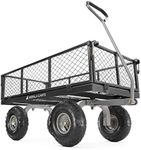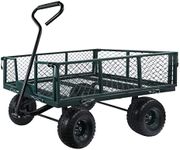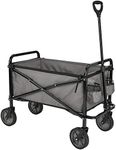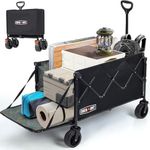Buying Guide for the Best Wagons For Dogs
When choosing a wagon for your dog, it's important to consider the specific needs of your pet and how you plan to use the wagon. Whether you're looking for a wagon to take your dog on outdoor adventures, or simply need a convenient way to transport them around town, there are several key features to consider. Understanding these features will help you make an informed decision and ensure that your dog is comfortable and safe during your travels.Size and CapacitySize and capacity are crucial when selecting a wagon for your dog. This spec refers to the dimensions of the wagon and the maximum weight it can carry. It's important because it determines whether your dog will fit comfortably inside. Wagons come in various sizes, from small ones suitable for toy breeds to larger ones that can accommodate bigger dogs or multiple pets. To choose the right size, measure your dog’s length and height, and ensure the wagon is spacious enough for them to sit, lie down, and turn around comfortably. Consider the weight capacity to ensure it can support your dog’s weight.
Durability and MaterialDurability and material refer to the construction quality and the type of materials used in the wagon. This is important because it affects the wagon's longevity and your dog's safety. Wagons made from sturdy materials like steel or heavy-duty plastic are more durable and can withstand rough terrain. The fabric should be tough yet comfortable, often featuring water-resistant or easy-to-clean materials. If you plan to use the wagon frequently or on uneven surfaces, opt for a more durable model. For occasional use on smooth surfaces, a lighter, less rugged option may suffice.
Wheels and SuspensionWheels and suspension are critical for ensuring a smooth ride for your dog. This spec involves the type of wheels (e.g., plastic, rubber, air-filled) and whether the wagon has a suspension system. Larger, air-filled rubber wheels are ideal for rough terrains as they provide better shock absorption, while smaller plastic wheels are suitable for flat, even surfaces. A good suspension system can further enhance comfort by reducing bumps and jolts. Consider where you will be using the wagon most often; for off-road adventures, prioritize wagons with robust wheels and suspension.
Portability and StoragePortability and storage refer to how easy it is to transport and store the wagon when not in use. This is important for convenience, especially if you have limited space or plan to travel with the wagon. Some wagons are foldable, making them easy to store in a car trunk or closet. Others may have detachable parts for compact storage. If you need to frequently transport the wagon, look for lightweight models that are easy to fold and carry. For home use with ample storage space, portability may be less of a concern.
Safety FeaturesSafety features are designed to keep your dog secure and protected while in the wagon. These can include harness attachments, brakes, and reflective materials. Harness attachments prevent your dog from jumping out, while brakes ensure the wagon stays in place when parked. Reflective materials enhance visibility in low-light conditions. If your dog is particularly active or you plan to use the wagon in busy areas, prioritize models with robust safety features. For calmer dogs or use in controlled environments, basic safety features may be sufficient.
Ease of UseEase of use refers to how user-friendly the wagon is, including aspects like assembly, maneuverability, and maintenance. This is important for ensuring a hassle-free experience. Some wagons come pre-assembled or require minimal setup, while others might need more effort. Maneuverability is influenced by the handle design and wheel configuration; adjustable handles and swivel wheels can make steering easier. Consider how often you'll use the wagon and your comfort level with assembly and maintenance. For frequent use, opt for a model that is easy to set up and steer.















